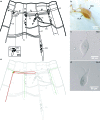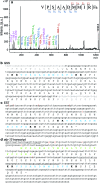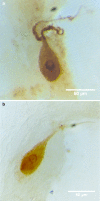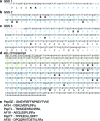Mapping neuropeptide expression by mass spectrometry in single dissected identified neurons from the dorsal ganglion of the nematode Ascaris suum
- PMID: 20806053
- PMCID: PMC2929024
- DOI: 10.1021/cn1000217
Mapping neuropeptide expression by mass spectrometry in single dissected identified neurons from the dorsal ganglion of the nematode Ascaris suum
Abstract
We have developed a method for dissecting single neurons from the nematode Ascaris suum, in order to determine their peptide content by mass spectrometry (MS). In this paper, we use MALDI-TOF MS and tandem MS to enumerate and sequence the peptides present in the two neurons, ALA and RID, that comprise the dorsal ganglion. We compare the peptide content determined by MS with the results of immunocytochemistry and in situ hybridization of previously isolated peptides AF2, AF8 and 6 peptides encoded by the afp-1 transcript. We find complete agreement between the three techniques, which validates single neuron MS as a method for peptide localization. We also discovered and sequenced 6 novel peptides in the ALA neuron. Cloning of cDNAs and database searching of Genomic Survey Sequences showed that transcript afp-12 encodes peptide AF36 (VPSAADMMIRFamide), and afp-13 encodes AF19 (AEGLSSPLIRFamide), AF34 (DSKLMDPLIRFamide), AF35 (DPQQRIVTDETVLRFamide), and 3 non-amidated peptides (PepTT, PepTL, and PepGE). We have found no similarities with reported peptide expression in the nematode Caenorhabditis elegans. This method promises to be ideally suited for determining the peptide content of each of the 298 neurons in the nervous system of this nematode.
Figures







Similar articles
-
Three independent techniques localize expression of transcript afp-11 and its bioactive peptide products to the paired AVK neurons in Ascaris suum: in situ hybridization, immunocytochemistry, and single cell mass spectrometry.ACS Chem Neurosci. 2013 Mar 20;4(3):418-34. doi: 10.1021/cn3001334. Epub 2012 Dec 27. ACS Chem Neurosci. 2013. PMID: 23509978 Free PMC article.
-
In situ hybridization of neuropeptide-encoding transcripts afp-1, afp-3, and afp-4 in neurons of the nematode Ascaris suum.J Comp Neurol. 2010 Mar 15;518(6):896-910. doi: 10.1002/cne.22251. J Comp Neurol. 2010. PMID: 20058230 Free PMC article.
-
Mass Spectrometry of Single GABAergic Somatic Motorneurons Identifies a Novel Inhibitory Peptide, As-NLP-22, in the Nematode Ascaris suum.J Am Soc Mass Spectrom. 2015 Dec;26(12):2009-23. doi: 10.1007/s13361-015-1177-z. Epub 2015 Jul 15. J Am Soc Mass Spectrom. 2015. PMID: 26174364 Free PMC article.
-
FMRFamide-related peptides (FaRPs) in nematodes: occurrence and neuromuscular physiology.Parasitology. 1996;113 Suppl:S119-35. doi: 10.1017/s0031182000077933. Parasitology. 1996. PMID: 9051931 Review.
-
The ever-expanding neuropeptide gene families in the nematode Caenorhabditis elegans.Parasitology. 2005;131 Suppl:S109-27. doi: 10.1017/S0031182005009376. Parasitology. 2005. PMID: 16569285 Review.
Cited by
-
Chemical analysis of single cells.Anal Chem. 2011 Jun 15;83(12):4369-92. doi: 10.1021/ac2009838. Epub 2011 Apr 28. Anal Chem. 2011. PMID: 21500835 Free PMC article. Review. No abstract available.
-
C. elegans Stress-Induced Sleep Emerges from the Collective Action of Multiple Neuropeptides.Curr Biol. 2016 Sep 26;26(18):2446-2455. doi: 10.1016/j.cub.2016.07.048. Epub 2016 Aug 18. Curr Biol. 2016. PMID: 27546573 Free PMC article.
-
Behavioral States.Genetics. 2020 Oct;216(2):315-332. doi: 10.1534/genetics.120.303539. Genetics. 2020. PMID: 33023930 Free PMC article. Review.
-
Mass spectrometry-based characterization of endogenous peptides and metabolites in small volume samples.Biochim Biophys Acta. 2015 Jul;1854(7):732-40. doi: 10.1016/j.bbapap.2015.01.008. Epub 2015 Jan 21. Biochim Biophys Acta. 2015. PMID: 25617659 Free PMC article. Review.
-
Neuroendocrine modulation sustains the C. elegans forward motor state.Elife. 2016 Nov 18;5:e19887. doi: 10.7554/eLife.19887. Elife. 2016. PMID: 27855782 Free PMC article.
References
-
- Kotani M.; Detheux M.; Vandenbogaerde A.; Communi D.; Vanderwinden J. M.; Le Poul E.; Brezillon S.; Tyldesley R.; Suarez-Huerta N.; Vandeput F.; Blanpain C.; Schiffmann S. N.; Vassart G.; Parmentier M. (2001) The metastasis suppressor gene KiSS-1 encodes kisspeptins, the natural ligands of the orphan G protein-coupled receptor GPR54. J. Biol. Chem. 276, 34631–34636. - PubMed
-
- Cottrell G. A. (1997) The first peptide-gated ion channel. J. Exp. Biol. 200, 2377–2386. - PubMed
-
- Marder E.; Bucher D. (2007) Understanding circuit dynamics using the stomatogastric nervous system of lobsters and crabs. Annu. Rev. Physiol. 69, 291–316. - PubMed
-
- Stretton A.; Donmoyer J.; Davis R.; Meade J.; Cowden C.; Sithigorngul P. (1992) Motor behavior and motor nervous system function in the nematode Ascaris suum. J. Parasitol. 78, 206–214. - PubMed
-
- Davis R. E.; Stretton A. O. (2001) Structure-activity relationships of 18 endogenous neuropeptides on the motor nervous system of the nematode Ascaris suum. Peptides 22, 7–23. - PubMed
Grants and funding
LinkOut - more resources
Full Text Sources

